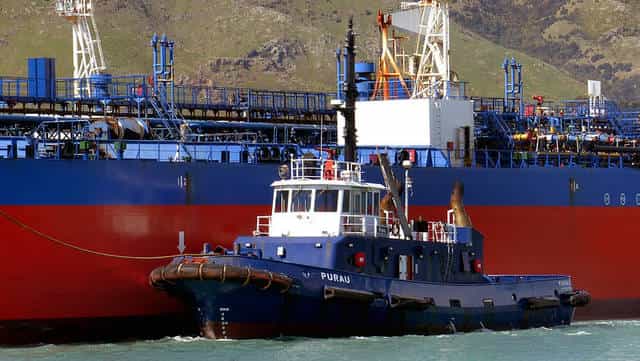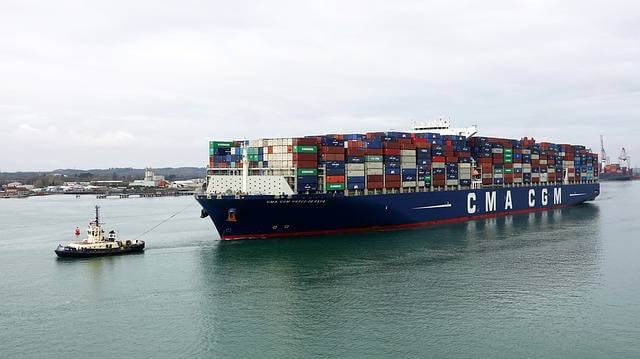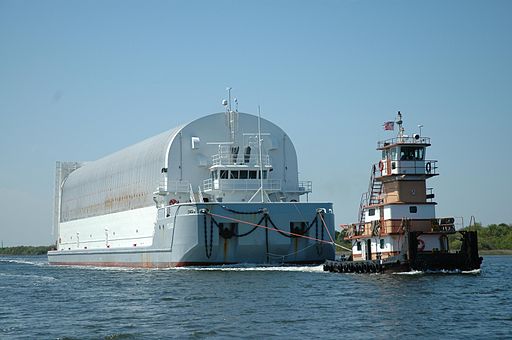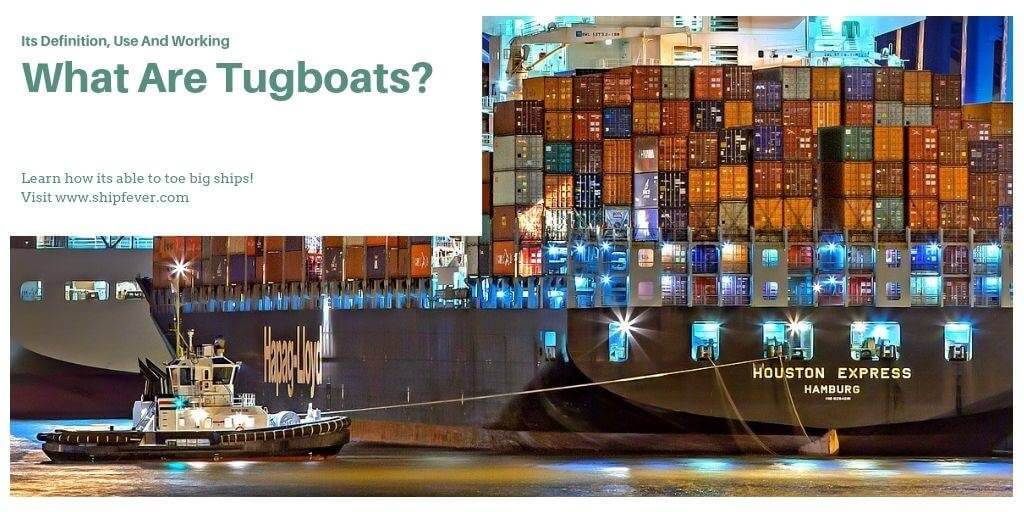Last Updated on July 29, 2020 by Amit Abhishek
A Tugboat or Tugboats are a special vessel used mainly near the harbor and ports to assist in docking of the ships. As discussed in my older post “Types of Boats“; a tug boat is a powerful vessel in a small form that uses push or pull to do its job. Its primary job is to assist large ships during maneuvering and docking operation.
The other use of tugboats is to tug or pull barges; oil platforms, disabled ships to carry them to the secured positions. Not just that, many a time they are also used as ice breakers do fire fighting duties and act as a salvage boat. It is also not uncommon to see them performing escort for a large ship in narrow waters.
With an average power of 700 to 3500hp, they are quite powerful in deep and shallow waters.
Being one of the first vessels to incorporate steam propulsion; they are considered pioneers in the development of the shipping industry.
These small yet powerful watercraft first built in 1736; for the support and salvage operation in Clyde Canal ( Scotland ).
The two main advantages of tugboats over other watercraft and ships is; its ability to maneuver easily in the most restrictive waters and its high power to weight ratio.
Tugboats are not just more powerful for their size but equally more strong and solid. They can be seen in rivers, near ports, and out in the ocean; yet only a few notice their presence due to its small size.

What Are Tugboats Used For ? – Its Types Based On Area Of Application
Ships began to grow bigger and bigger with the development of the shipping industry starting from the late 20th century.
In less than a century they become so large; it practically becomes impossible to turn the ship in narrow channels or near ports.
Since each sip is required to dock in a preassigned position; tugboats become an important aspect of the shipping industry.
Without a tug boat, it is almost impossible to berth a very large ship at the port. Other than its primary operation to assist the large ship’s in mooring and berthing operation; it also take part in a number of port activities at times. Overall they have been used to tow, assist and escort ships near ports and in congested waters.
Thanks to its solid structure and high power to weight ratio; they also act as salvage boats, icebreakers and utility boats for barges and oil platforms.
Many a time they are also seen as shifting offshore drilling platforms. This enormous strength and power came from its unique propulsion system.
Based on there specific use and area of operation; a tugboat or tug boats can be classified into 3 main types:
1 ) Seagoing Tugboats
Made with high strength material these boats are built to go out in international waters and generally have the most powerful engines.
A little bigger than its other subtypes; they have a power to tonnage ratio of about 2:4.5 to 2.2:5. Equipped with towing lines they tow ships, other boats, and other watercraft.
Out in the open sea they salvage ships and boats that undergo engine failure, or receive significant damage from collision or grounding.
These vessels are then towed using towing lines capable of handling ships of much larger sizes with free movement. This free movement of towing lines is often ensured by having a low aft deck structure.
Ranging from 150 to 250 feet in length these boats are generally called upon to do heavy-duty jobs at sea; such as shifting drilling platform, barges, and damaged ships.
Other than that they are also used for fire fighting and other emergency responses at sea. Other than that they are often used in navy across the world for support and patrol purposes.
2 ) Harbor Tugboats
A harbor tug is the one we usually see near ports handling and supporting proper docking of the ships. These tugboats do this by using push and pull to rotate and position the ship in a particular position.
It is hard for any ship to turn 360 degrees in such congested water; and if it wasn’t these tugs it would be a challenge.
They are designed for both assisting and towing purposes and so are generally termed as multi-purpose tugboats.
Having such high demands they have a higher power to tonnage ratio; in comparison with other tugboats of 4:10 or 3.9:9.5. The majority of harbor tugs that we see are of azimuth stern drive type.
In some cases, you may also find another more powerful tugboat called tractor tug; which includes benefits such as 360 degrees turning at full capacity while towing a ship.
The other benefits include instant power, better control, excellent maneuverability, and better response. Irrespective of its type ( azimuth stern drive vs tractor tug ) harbor tugs have the most maneuverability than others.
3 ) Escort Tugboats
If you ever been on any ship without bow thruster you must have noticed tugs assisting in your ship near canals and in the area with a narrow passage.
These specialized tugboats which are designed to assist in the maneuverability of very large ships; in restricted waters are best known as the escort tugboats.
Other than that escort tugs came into rescue; when your ship’s main propulsion system fails or has trouble steering the ship.
Thus you can find them near canals, harbors, ports, and channels; where there are huge risks of pollution and maritime safety due to engine failure or steering gear defects.
Thus the first escort tugboat was used for an oil tanker in 1975. On many ports around the world having an escort, tugboat is made compulsory as part of safety.
The boat can use both direct or indirect mode of operation or either of the two. Thanks to the growing size of ships newer tugs are having more and more bollard pull.
Types Of Tug Boat Based On Their Application Or Purpose
A ) Escort Tug boats
These are the specialized tug boats used to assist the ship in navigation in local waters. They are usually found near a canal or a narrow sea area of strategic importance. These are generally the first tug boats that came to rescue operation in an emergency. Other than that they are also used to maneuver ferries from one place to another.
Note: Already Discussed above so not going in details
B ) Support Tug boats
The name support tugs themself gives a brief idea about them; what they do and how much could be their size. These are the ones used for supporting other vessels near and around the harbor or ports.
They are generally involved in towing and berthing operations. There are many distinct types of support tug available based on their design capabilities.
And the only thing that sets them apart is their maneuverability, strength, and control.
In a crowded harbor, even with bow thrusters, it becomes impossible sometimes to securely berth a ship without using a tug boat.
Thus its a necessity for most ports otherwise the whole operation will be exceedingly difficult and risky.
It’s all about the collective exercise of exerting forces at the designated places on a ship to turn it efficiently by 360 degrees.
Since a ship has ample power and means for the backward and forward movement. The tug boats generally just assist them with their sideways movement.
While on some ports there are local laws that make it compulsory to have tug assistance; most ships just do because it reduces both the risks and effort of mooring operation.
1 ) Conventional Tug Boat
They are the simplest of the tug types used by our forefathers and still in service. While they have lesser maneuverability compared to moder design; they are cheap and simple to maintain.
Thus you can still find them around near most ports across the globe. They usually have either a single or multi propper driven by a diesel engine.
The propeller used can be of single screw, double screw or multi screw type with a conventional rudder. They usually have a towing hook provided at their center.
The position of that towing hook is of great importance; as the safety and performance of the tug depend much upon the position of towing hook.
The major advantage of using conventional tugs is its low operational and maintenance costs. Furthermore, it is easy to maintain and is also self-sufficient.
Their downside is low astern power, lesser efficiency, stability issues, and operational hazards in the form of risk involved of capsizing while the operation.
2 ) Azimuthal Stern Drive
It is a special type of tug that utilizes the power of two rotating azimuthal stern drive for propulsion. This not just saves the space and mass of having a dedicated marine engine but also improves the power significantly.
The design helps with both speed and stability of the vessel; thus making it suitable for work in open waters.
This boat holds two towing locations one at the front and one at astern. With better bollard pull, efficiency and towing power it’s better used for the largest vessels to assist in their berthing.
The major advantage of azimuth stern drive over conventional tug is that it can work well even under shallow waters.
The azimuth themselves are much easy to remove, inspect and do regular routine maintenance. It also features a much better heel with a side thrust of around 15 degrees.
Thus improving its directional stability while at high speed or doing towing operation under full power.
3 ) The Tractor Tugs
These are the big boys of the tugs world with a heel to side thrust of around 21 degrees. It possesses such a better control thanks to its multidirectional propulsion unit.
Which is either in the form of an outboard motor or double blade rotating blade. Thanks to its design and location of the towing point at stern much nearer to its propulsion unit; it posses a positive towing moment.
This all makes it a versatile machine with better control, power, and speed. Thus they are much more flexible than both astern and conventional tugs and have a better response time.
These are really great for the sideways movement as it is the only tug boat that provides the full towing force for complete 360-degree rotation.
It put it into a much superior category with the ability to easily overcome the interaction forces; that a boat feels or undergoes as it interacts or came too close to a larger ship.
The only disadvantage is that they have a lesser bollard pull and are not cost-effective. Meaning it required huge capital investment and running cost.

How Tugboats Work Or Do Its Job
Although tugboats look much small and helpless with respect to big ship but it drastically reduces the berthing time. Even with ships using bow thruster; a tug can rotate them 10 times faster than using big bow thruster.
That is achieved by the sound grip of the tugs on ships hull, its powerful engines, and simple forces such as a push or pull.
A tug does its job by using either the direct approach or indirect ones. Most conventional and azimuth harbor tugs often work in a team and push the ship in order to turn it.
They use their high power engine ( 3 to 4 thousand hp ) and heavy displacement hull to generate more grip and displacement in water.
They use a turbocharged four-stroke marine diesel engine with a computer monitored fuel injection system; that provides enough power to tow most ships on their own.
Having a low freeboard with heavy displacement hull design makes sure the tug stays low in the water. This helps generate more friction with water meaning more power with a steady boat.
In the indirect approach tractor tugs and azimuth harbor tugs hook on to the back of the ship; now using the towing line and its powerful propulsion it turns the ship on its own.
With that being said I do not want to neglect the importance of waves, wind, and weather condition that affects this process.
Step’s Followed In Ship’s Towing Operation
All concerned parties tugs, ship’s and the port control must follow a particular code of conduct while entire towing operation. Such code of conduct followed by step by step instruction; are all in all part of ports navigation safety system which is pat of the international ports marine safety code.
All concerned parties must be aware of the role he or she has to play in the entire sequence of events. These steps include planning, Pilot -Master exchange, communication, preparedness, connecting towing gear, safe operation and disconnecting of the towing gear.
- Planning: After the pilot has embarked on the ship; A detailed action plan must be discussed and agreed upon between the ship’s master and the pilot before the towing operation. All necessary maneuvers and the number of tugs to be allocated for assistance are discussed beforehand. This includes number and types of tugs to be used, towing positions, number of personnel involved, present conditions, etc. Conflict if any is resolved all before the actual towing operation starts.
- Pilot-Master Exchange: Apart from the brief introduction and planning there must be a formal exchange of key information between the pilot and the ship’s master. The pilot must inform the master about the mode of towage, tug rendezvous, planned ship speed, minimum and maximum towing force, maximum speed of tug, area of transit and lines of communication with active VHF channels. Similarly, the master must brief the pilot about self-working limits of mooring fittings, chocks/bollard/points to be used for towing, areas of hull strengthened and any other important information such as bow thruster/CPP etc.
- Communication: Before the towing operation line of communication is being agreed upon between the ship’s master, pilot, tug master, and the port authorities. VHF communication channels and Vessel Traffic Services acts as the major communication channel between the concerned authorities. Once VHF communication is established between the ship and the tug; it must be tested and then used through the towing operation. It is important that proper means of communication is maintained throughout the operation.
- Preparedness: Towing ropes and wraps are under huge load and tension during the entire mooring and towing operation. Sudden failure in any part can result in acute damage to the ship and boat with certain loss of life and heavy injuries. That is why its a must to take precautions before starting towing operation. All running gear such as ropes must be checked for wear or damage and checked for sufficient strength. All other associated equipment & gear must also be inspected and tested for correct operation.
- Connecting Towing Gear: Before connecting towing gear the ship’s speed must be sufficiently reduced; as to allow safe connection and rendezvous with the tug. Both ships and tug relative position and speed must be closely monitored and administered with the VHF channels. Before commencing to tow, it must agree upon which towing gear to be used before the heavy lines are being transmitted. The towing gear must be free of any obstruction and is able to run freely under its maximum load limit.
- Safe Operation: To ensure safe operation all crew or associated personnel must stay away from danger zones. If possible all personnel if not required must be instructed to move away after completing its job. The working crew must be aware of the risks involved and what to do to stay away from possible dangers. They must also be aware that the mooring lines can sometimes automatically disconnect in an emergency. And at all times continues communication must always be maintained.

How Powerful Is A Tugboat & How Come It Able To Toe Large Ships?
The power and capability of a tug boat are measured in the form of its maneuverability and engine power. The power is determined by the amount of torque the engine produces or horsepower. Similarly, the ability turn, pick up speed and stop within record time and distance determine its maneuverability.
On average a tug can have an engine with power in between 3 to 6 thousand horsepower. A 3 thousand horsepower engine can allow tugs to toe ships as large as an aircraft carrier. It is for the ULCC that tugs of greater power are required. Similarly, a tug should be capable of turning a complete 360 degree almost within her length.
Moreover, it must go from its maximum speed forward to maximum speed back in not less than 15 seconds. The reason for all this power and agility is simple; to be able to toe large ships maintaining safe maritime passage. Thanks to the unique ability of water to exert less friction; any small vessel can push or pull a large ship.
These tugs are equipped with strengthening winch and additional stability that helps them exert more torque and strain on the towing line; thus exerting necessary force to toe the ship.
To turn they also apply forward push in teams of two and three on dedicated positions on the ship’s hull. All big ships have these soft positions marked on the hull; making it easier for tugs to do their job.
Common Doubts & Questions ( Tugboats )
Q.1. Why do some tug boats spray water near ports?
Ans: While its not much of a required job or event but rather a long ceremonial custom to welcome arriving ship at port. Right from the early days of shipping, it is in tradition to spray water in the air using fire hydrants and nozzles. This is done to give due respect to any vessel or on special occasions.
Q.2. Why Do Tugs Stay Far Ahead Of The barges Or Ship It Toe?
Ans: There is no such thing as brakes in water and you will not stop just because your engines are on hold or down. In the condition when a ship or barge ( a water vessel without engine ) is toed by a tug; it is common practice to maintain a safe distance. If not there can be accidents and the barge or ship can collide with the tug.
Q.3. Does Tugs Too Have Anchors?
Ans: Every water board vessel that has its own propulsion system has an anchor. It is another thing that its not that big as many other boats of similar size or power do have. It is so because they are mostly in service and rarely required to anchor and wait for the orders. They can have either conventional anchor or the one which they can lower with the windlass.
Q.4. Why Do Most Tugs Push More Than Pull?
Ans: Since a majority of tugs are used near harbor and ports they generally assist in berthing/docking of the large ships. On most occasions they are not required to toe; and so it always easier and safe to push the ship on marked position to turn it using tugs. That is the reason why many people find them pushing near ports, but away from ports they usually toe or pull other water vessels. Even in ports, bigger tugs tend to pull more than pushing them.
Also Read:
- How Lifeboat Work And Where Are They Used?
- How Fast Can A Boat Go? | Get Answered
- What Are The Different Boat Types? | Explained With Pictures
- Marine Terminology For Boat Ships & Sailors

